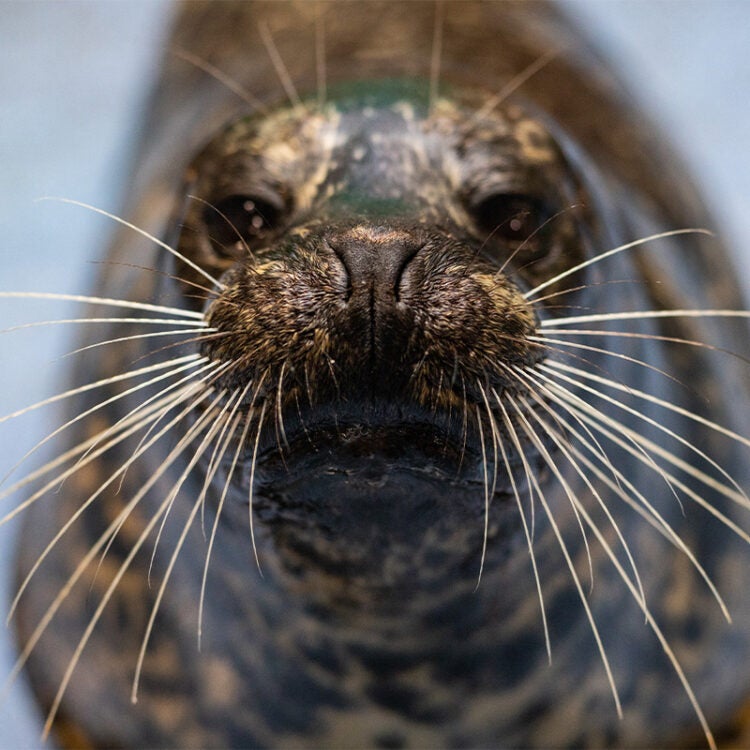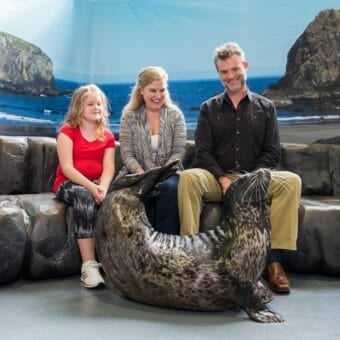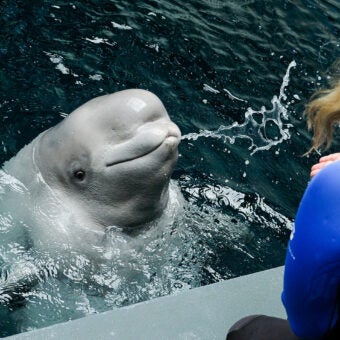-
Size
4-6 feet (1.2-1.8 m) in length, weighing up to 375 lbs. (170 kg) -
Diet
Fish, octopus, squid, crustaceans and mollusks -
Range
Arctic waters of the North Atlantic and North Pacific Oceans -
Habitat
Shallow, near-shore waters of bays and estuaries, rocky shores and glacial fjords
Physical Characteristics
Size
- Adult harbor seal can reach 4 to 6 feet (1.2 -1.8 m) in length and weighs up to 375 lbs. (170 kg).
- Males are slightly larger than females.
- Pups are about 30 to 39 inches (76-99 cm) long at birth and weigh approximately 24 lbs. (11 kg).
Flippers
- Short webbed flippers in front are made up of five digits of equal length. Each digit has a short, blunt claw.
- Rear flippers are also webbed and have claws, and can be spread out into a wide fan shape.
- The harbor seal cannot rotate its rear flippers under its pelvis like the sea lion can. It moves on land with a caterpillar-like motion.
Fur/Whiskers
- The coat of the harbor seal ranges in color from silver-gray to black or dark brown. It is covered with spots or rings, which are more numerous on the back; in overlapping parts of their range, the harbor seal is often mistaken for the spotted seal.
- Fur is thick and short with coarse guard hairs and finer, denser under hair. Hair density increases with age.
- The harbor seal molts each year after the breeding season. It gradually loses its hair in patches. Molting lasts one to two months.
- There are oil glands in the skin that help waterproof the fur. The hair does not provide insulation.
- Long whiskers (“vibrissae”) on the seal’s face grow from thick pads on the upper lip and cheeks. They are used to detect prey in low light conditions by touch, vibration or water movement.
Vision/Eyes
- The eyes are large and provide excellent underwater vision, particularly in low-light conditions. Vision on land is less acute.
- This seal has no tear ducts, so its eyes always have a tear-rimmed appearance out of water.
Ears
- This seal is a member of the family Phocidae, and therefore does not have ear flaps (as opposed to the sea lion, a member of family Otariidae).
Animal Fun Fact
The harbor seal's whiskers help it detect prey in low light.
Diet / Feeding
- The harbor seal is an opportunistic feeder that preys on a variety of fish (rockfish, herring, flounder, salmon, hake and cod) as well as octopus, squid, crustaceans and mollusks.
- Diet varies seasonally and by region.
- Consumes an estimated 5-6% of its body weight daily.
- Front teeth are sharp and pointed for grasping and tearing. The back teeth are flat and used for crushing shells and crustaceans.
Range / Habitat
- Sometimes referred to as the common seal, the harbor seal occurs in temperate, subarctic and Arctic waters of the North Atlantic and North Pacific Oceans. It is the most widely-distributed pinniped.
- Found in shallow, near-shore waters of bays and estuaries where sand bars and beaches are uncovered at low tide, as well as rocky shores and glacial fjords.
Reproduction & Growth
- Sexual Maturity: Males-between 3-7 years of age and Females-between 2-6 years of age
- Mating occurs from late spring to fall, depending on region.
- Females usually mate every year about six weeks after their pups are born. Males may mate with several females each breeding season. Mating behavior includes chasing, neck and flipper-biting and embracing.
- Gestation lasts 9 to 11 months. Pups are born from February to July, depending on the region. Birthing occurs on land, ice or in the water near shore. A single birth is the norm; twins are rare.
- The mother harbor seal recognizes her pup by smell and vocalizations.
- On average, pups are nursed for 24 days.
Conservation Status
- “Least Concern” on the IUCN Red List.
- As of 2008, the worldwide population of harbor seals is estimated to be 350,000 to 500,000.
- Populations in the Eastern North Pacific may number 180,000 individuals. There are multiple recognized subspecies of harbor seal.
Additional Information
Diving/Swimming:
- This species spends about half of its time in the sea and half on land. It will sometimes sleep in the water.
- The harbor seal can dive to 1500 feet (457 m), but typically only makes shallow dives.
- It can remain submerged for 40 minutes but often limits dives to 3-7 minutes.
- Pups can swim at birth and will sometimes ride on their mother’s back.
Haul-outs:
- Unlike most pinnipeds, the harbor seal is usually solitary and rarely interacts except to mate. However, it does haul out in loosely organized groups made up of both sexes and all ages.
- Reasons for haul-outs include thermoregulation, resting, giving birth, nursing pups, molting and avoiding predators.
- Haul-outs are made onto rocks, ice, and beaches at any time of the day or night.
- Harbor seals will also haul out onto manmade structures including docks and wharves. While on land individuals are on constant alert and will quickly rush back into the sea when alarmed.
- The harbor seal will share a haul-out area with California sea lions and northern elephant seals.
Lifespan:
- Maximum lifespan: Up to (though very rarely) 35 years.
Predators/Threats:
- Predators of the harbor seal include killer whales, sharks, polar bears, Steller sea lions, walruses, coyotes and eagles.
- Human threats include boat strikes, pollution and human interaction.





